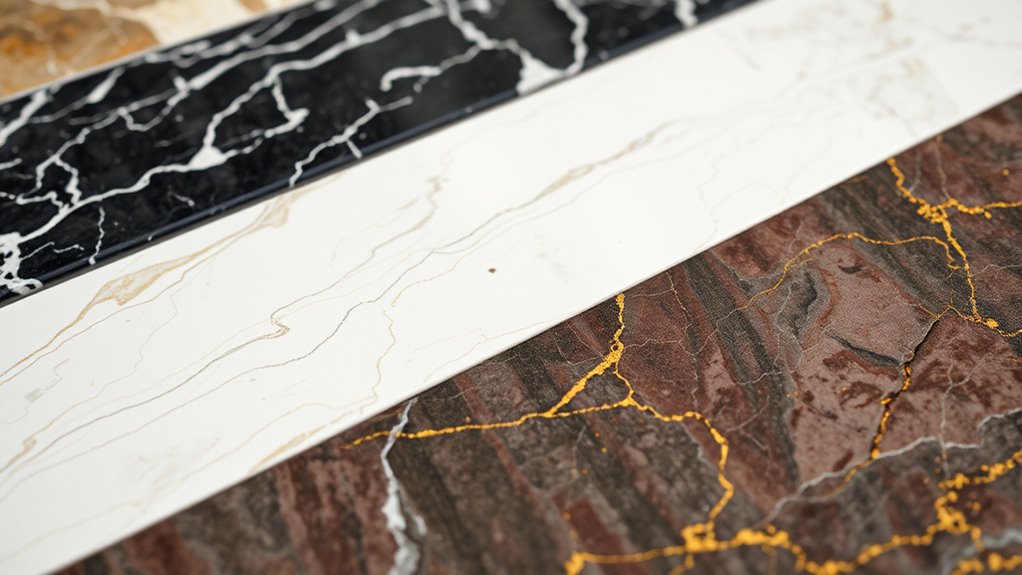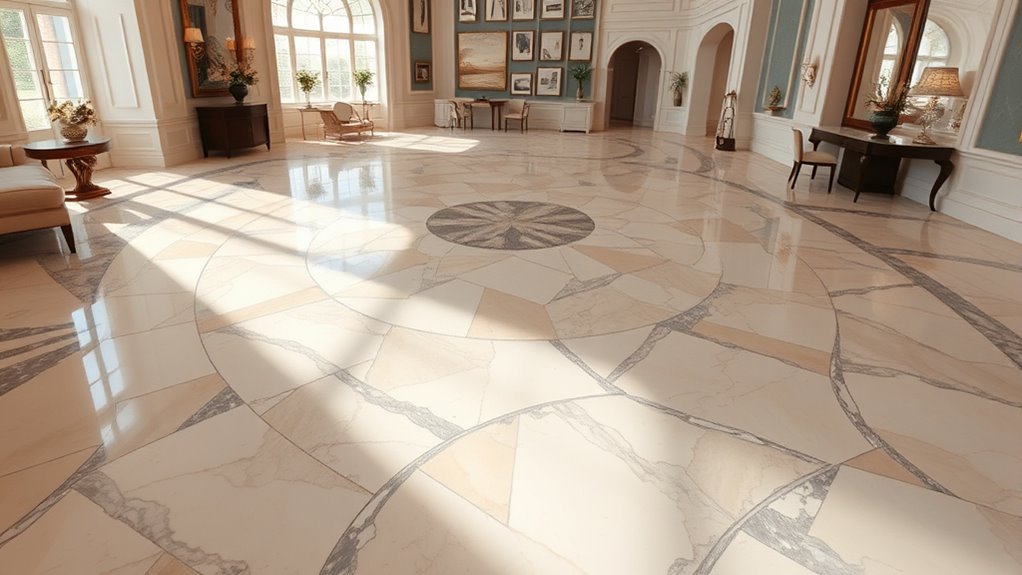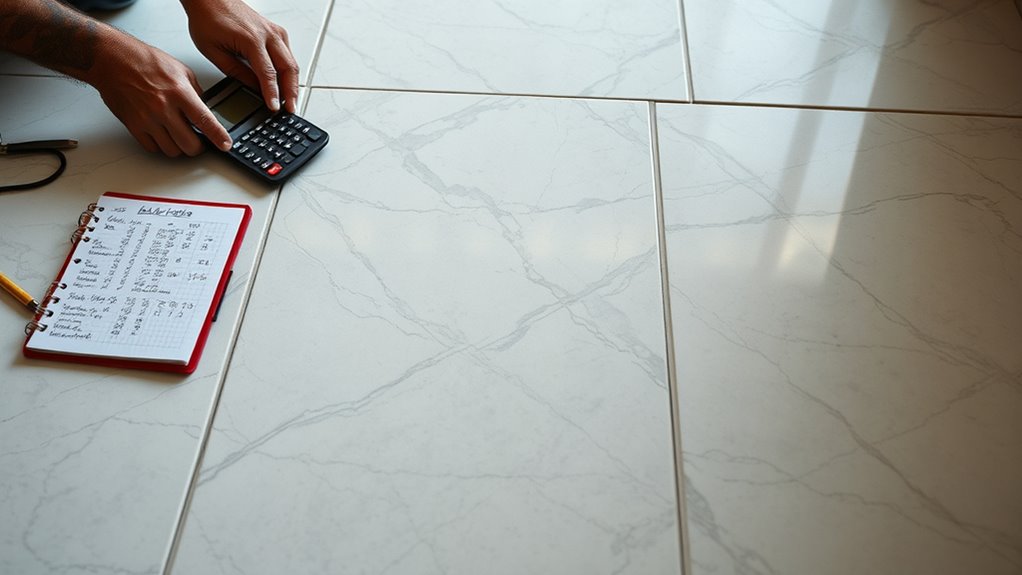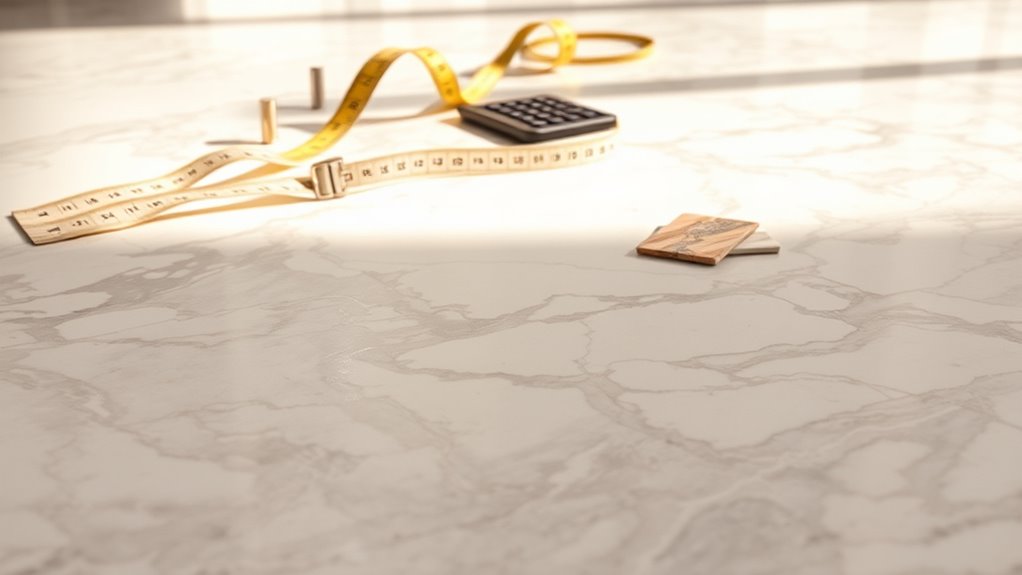When considering marble flooring, you’ll find that the type and quality of the marble play a major role in cost—rarer stones demand more. The size and thickness of tiles affect price and durability, while the area and layout complexity influence how much material and labor you’ll need. Preparation of your subfloor is essential for a lasting finish, and skilled installation impacts both cost and elegance. Plus, finishing choices and location add subtle but important price shifts. Explore these details to perfectly balance beauty and budget.
Type and Quality of Marble

Marble’s type and quality play an essential role in determining your flooring costs, as each variety offers distinct textures, colors, and durability levels. When you choose marble, consider how marble sourcing influences price—rare or imported stones often carry a premium, reflecting their unique origin and craftsmanship. Your selection should align with your lifestyle, as some marbles demand more marble maintenance to preserve their natural beauty and longevity. You’ll want to balance your desire for exquisite aesthetics with practical upkeep. Opting for higher-quality marble means investing in a surface that resists wear and retains its elegance over time, granting you the freedom to enjoy a luxurious space without constant worry. Understanding these nuances helps you make an informed choice that fits your personal style and budget.
Size and Thickness of Tiles
Beyond choosing the right type and quality of marble, the size and thickness of your tiles greatly influence both the look and cost of your flooring. Larger tile dimensions create a seamless, expansive feel, perfect if you want your space to breathe freely. However, bigger tiles often come with a higher price tag and demand precise installation. Thickness variation also plays a role—thicker tiles offer durability and a luxurious heft but can increase material and labor costs. Thinner tiles may be more affordable but might not provide the same longevity or visual impact. By carefully selecting tile dimensions and thickness that suit your style and lifestyle, you maintain control over your budget while ensuring your marble vloer reflects your personal taste and desire for freedom in design.
Area and Layout Complexity

When planning your marble flooring, the size of the installation space directly influences the overall cost, as larger areas require more material and labor. The complexity of your chosen design also plays a vital role—intricate patterns demand careful craftsmanship and extra time. Understanding these factors helps you balance your aesthetic vision with your budget effectively.
Size of Installation Space
The size and shape of your installation space play an essential role in determining marble flooring costs. When considering installation dimensions, larger areas naturally require more materials and labor, increasing the overall investment. But it’s not just about size—how efficiently your space is utilized matters too. A well-planned layout maximizes space utilization, minimizing waste and installation time, which helps control costs. If your room has straightforward dimensions, installation flows smoothly, keeping expenses predictable. On the other hand, irregular or expansive spaces can demand more cutting and fitting, subtly pushing costs higher. By understanding your space’s specifics, you can better anticipate the investment needed, ensuring your marble flooring not only elevates your home’s aesthetic but also aligns with your budget and freedom to create a seamless, beautiful environment.
Design Intricacy Impact
Although size sets the stage, the intricacy of your marble flooring design truly shapes the final cost. When you choose complex layouts with varied pattern variation, you’re embracing design aesthetics that demand more precision and time. Intricate designs with small, irregular pieces or elaborate mosaics require skilled craftsmanship, increasing labor costs. The more detailed and unique your layout, the more the installation process slows, impacting your budget. But this complexity also grants you freedom to express your personal style, turning your floor into a statement of elegance. Whether you opt for subtle geometric patterns or bold, artistic arrangements, the layout’s complexity directly influences pricing. Keep in mind: the balance between your design vision and cost is key to achieving a marble floor that’s both stunning and tailored to your lifestyle.
Preparation and Subfloor Requirements
Since marble is a natural stone that demands a stable foundation, you’ll need to guarantee your subfloor is impeccably prepared before installation. Evaluating subfloor conditions and applying precise preparation techniques guarantees your marble flooring lays flawlessly, preventing cracks or uneven surfaces. Whether your subfloor is concrete, plywood, or another material, thorough leveling and moisture control are essential to maintain marble’s timeless beauty and durability.
| Subfloor Type | Key Preparation Techniques | Importance for Marble Flooring |
|---|---|---|
| Concreet | Leveling, moisture barrier | Critical for stability |
| Multiplex | Reinforcement, leveling | Prevents flexing, cracking |
| Existing Tiles | Removal, surface cleaning | Garandeert een goede hechting |
| Radiant Heat | Compatibility check | Avoids thermal damage |
Your careful attention here means your marble floor will remain a stunning, long-lasting freedom statement.
Installation Method and Labor Costs

When you choose marble flooring, how it’s installed plays a major role in the overall cost and quality of the finished surface. Your choice of installation techniques directly influences labor rates and the durability of the floor. Skilled artisans may charge more, but their expertise guarantees a flawless, lasting look that complements your freedom to design.
Installation techniques shape both the cost and elegance of your marble floor’s final appearance.
Consider these factors when planning your installation:
- Complexity of installation techniques, like intricate patterns or large-format tiles
- Labor rates varying by region and the installer’s experience
- Time required for precise cutting, laying, and alignment
Finishing and Sealing Options
Because marble is a natural stone, the finishing and sealing choices you make can dramatically impact its appearance and longevity. You’ll want to explore various polishing techniques that enhance marble’s natural veining and shine, from a high-gloss finish that dazzles to a honed, matte look for subtle elegance. Each technique reveals a different character, allowing your flooring to express your personal style freely. When it comes to protection, selecting the right sealant types is key. Penetrating sealants preserve breathability while repelling stains, while topical sealants add a glossy protective layer but may require more upkeep. Choosing the ideal combination guarantees your marble remains stunning and resilient, offering you both beauty and peace of mind in your living space.
Geographic Location and Market Rates
Although marble flooring offers timeless elegance, the cost you’ll encounter can vary considerably depending on your geographic location and prevailing market rates. Understanding regional pricing is key to planning your investment wisely. In areas where market demand for luxury flooring is high, prices naturally rise, reflecting both scarcity and desirability. Conversely, regions with abundant marble sources or lower demand often offer more competitive rates. Consider these factors to align your budget with your vision:
Marble flooring costs vary widely by location, influenced by demand, availability, and regional market conditions.
- Local availability of marble and transportation costs
- Competitive pricing influenced by regional installation experts
- Economic fluctuations impacting supply chains and labor




